Design & Construction Standards
Traffic and Safety Resources
Rumble Strips - Frequently Asked Questions
Click on a question to read the answer.
- What are rumble strips?
- How do shoulder rumble strips increase highway safety?
- How do centerline rumble strips increase highway safety?
- Why install rumble strips in Alaska?
- What is the effect of shoulder rumble strips on bicyclists?
- Why use centerline rumble strips in passing zones?
- Are rumble strips safe for motorcyclists?
- Do rumble strips cause noise problems for nearby residents?
- Do rumble strips damage the pavement?
- How do drivers react in locations where centerline rumble strips are used in passing zones?
- How many states use centerline rumble strips and what is their combined experience?
- Are rumble strips still effective in the winter?
- What design criteria are Alaska DOT/PF using for Rumble Strip installation?
What are rumble strips?
Rumble strips are grooved patterns rolled or milled into the pavement perpendicular to the direction of travel. They can be installed on the centerline of the roadway or on the roadway shoulder. The driver of a vehicle passing over a rumble strip hears an audible warning (rumbling sound) and feels a vibration. These physical and audible warnings alert the drowsy, distracted or impaired driver, thus reducing the chance for a crash.
Milled-in rumble strips ground into the pavement are preferred over rolled-in rumble strips. Rolled-in rumble strips were previously used in Alaska throughout the 1990’s. A study by the Virginia highway department showed milled-in rumble strips produce a vibration level 12 times greater than rolled strips. Inside the vehicle the sound volume from radio and conversation can diminish some of the audible benefits of rumble strips, but most drivers can't miss the physical effect of the vibrations to the car. Milled-in rumble strips have been demonstrated to be the best design for reducing fatal and major injury crashes.
These photos compare old Rolled-in Rumble Strips with newer Milled-in Rumble Strips
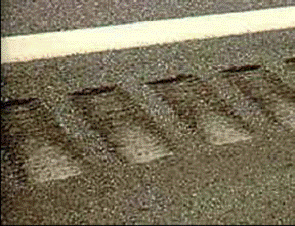
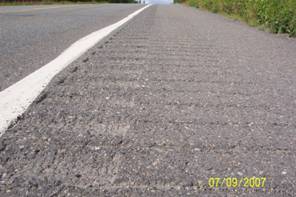

How do shoulder rumble strips increase highway safety?
Rumble strips on the shoulders reduce run-off-the-road crashes by warning drivers they are leaving their lane. They are located just beyond the white line or the traveled portion of the roadway. As of 2009, over 35 states use shoulder rumble strips on their roadways.
Two-Lane Two-Way Highway Performance
In Alaska, about 36 fatal crashes per year are due to run-off-the-road crashes on two lane roads. Shoulder rumble strips are one of the most cost-effective countermeasures for these crashes. A review of the performance of shoulder rumble strips installed since 2000 in Alaska shows a 22% decrease in fatal and injury crashes statewide. A 29% reduction was achieved in southcentral Alaska on roads with shoulder rumble strips. Statewide, over 5 lives and 17 serious injuries are estimated to have been prevented each year where rumble strips have remained in place.
Minnesota studied shoulder rumble strips on their two-lane two-way rural highways. They reported 40% of all 2004 fatal crashes were single-vehicle, run-off-the-road (SVROR) crashes. Milled-in continuous shoulder rumble strips were installed at 23 treatment sites (183 miles). The result was a 13% reduction in all SVROR crashes and an 18% reduction in injury-producing SVROR crashes after shoulder rumble strips.
Source: (Estimating Safety Benefits of Shoulder Rumble Strips on Two-Lane Rural Highways in Minnesota: Empirical Bayes Observational Before-and-After Study )
Freeway Performance
Alaska data from 2001 through 2006 was not conclusive enough to show any benefits due to the small segments of freeway which remain treated with shoulder rumble strips in Alaska. However, data from other states suggests they will be effective at reducing crashes in the long term. Alaska crash data demonstrates there is a crash problem even when roads are dry and uncongested.
California and Illinois data were combined from the Highway Safety Information System (HSIS) to estimate the safety effects of shoulder rumble strips on freeways. Before-after evaluations estimate single-vehicle run-off-the-road crashes were reduced on average by 18.3 percent on all freeways (no regard to urban/rural classification) and 21.1 percent on rural freeways. Two potential adverse effects related to safety were analyzed. The crash risk due to driver startle/panic responses and the potential for crash migration were explored. The research findings show these potential adverse effects are insignificant.
Source: Safety Evaluation of Continuous Shoulder Rumble Strips Installed on Freeways, December 1999, FHWA-RD-00-032
California performed a before-and-after study in 1985 which indicated a 49 percent reduction in run-off-road crashes after shoulder rumble strips were installed along sections of Interstate 15 and 40 in San Bernardino County. Recent follow-up evaluation for freeway segments where shoulder rumble strips have been in-place for 3 or more years indicated an average reduction of 33 percent statewide.
The Pennsylvania Turnpike tested shoulder rumble strips of various lengths and depths of grooves to select a design with enough sound and vibration to be perceptible in a truck cab and yet not too severe for cars or motorcycles. A before-to-after reduction of 70 percent led to accelerating shoulder rumble strip installation for all roadway segments including those that had been recently repaved and were not scheduled for resurfacing for several more years.
The Turnpike installed shoulder rumble strips on over 53 segments totaling 348 miles of roadway. The resulting crash reduction was 60 percent. Crashes involving single vehicles that drove, rather than slid, off the right side of the roadway were reduced from 3.81 accidents per 100 MVM (2.37/100MVK) before shoulder rumble strip treatment to 1.54/100 MVM (.96/100MVK) after treatment.This type of crash was 11.6 percent of 2,972 total accidents on the Pennsylvania Turnpike in 1990 and 1991 before the shoulder rumble strip installation program could have had any appreciable effect.
Source: Shoulder Rumble Strip Effectiveness: Drift-Off-Road Accident Reductions on the Pennsylvania Turnpike, 1997, TRR 1573.
How do centerline rumble strips increase highway safety?
Centerline rumble strips are effective at reducing head-on, sideswipe and crossing-the-centerline crashes on two-lane, rural highways. These crashes are of great public concern because they often impact innocent motorists and passengers in a second vehicle. The crash cause is typically driver inattention, error, fatigue, or impairment. An Insurance Institute for Highway Safety study showed all crash types were reduced by 15 percent, while head-on and opposing direction sideswipe crashes involving injuries were reduced by 25 percent.
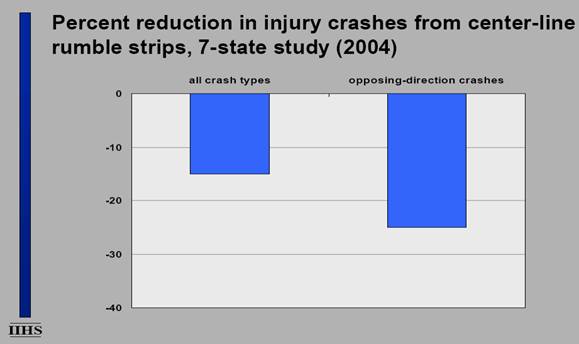
Data compiled by the Insurance Institute for Highway Safety from: “Crash Reduction Following Installation of Centerline Rumble Strips on Rural Two-Lane Roads, IIHS, September 2003
In the year 2000, 20 states had a combined total of 200 miles of centerline rumble strips on a few roadways. The five states with the most miles comprised 100 miles total. By the year 2003, 22 states were using centerline rumble strips for a combined total of approximately 1100 miles. The top five states had 850 miles. Since 2003, at least two states (Pennsylvania and Missouri) have new policies to install centerline rumble strips statewide on their two-lane rural roads.
Two-Lane, Two-Way Highway Experience
Alaska installed centerline rumble strips in 2000 on horizontal curves on the Seward Highway along Turnagain Arm. Centerline rumble strips were added to Turnagain Hill in 2003 which had a history of head-on collisions. In 2007, two isolated, high crash curves with an increasing history of fatalities over the last five years were also treated on the Sterling Highway (MP 52 and MP 168). Head-on collisions and fatalities have been significantly reduced since these installations. There is not enough data on these short segments to justify drawing conclusions until more years pass. However, data from other states suggests they will be effective at reducing severe crashes in the long term.
Washington reported a 37 percent decrease in crossover collisions and a 55 percent decrease in fatal and disabling crossover collisions over a two year period. This was for 107 miles of rural two lane highway where centerline rumble strips were installed in both passing and no-passing areas.
In Delaware, average yearly head-on collisions decreased by 95 percent after the installation of centerline rumble strips on both passing and no-passing areas on a high crash section of US 301, 3 miles long. Crashes caused by motorists crossing the centerline decreased by 55 percent. Even with a four percent average yearly increase in traffic volumes, there were no fatal accidents reported during the seven-year period after installation of the centerline rumble strips. There were 2 per year in the “before” period (1991-1994)
Nebraska noted a 44 percent reduction in combined fatal and injury crashes following the installation of centerline rumble strips in both passing and no-passing zones.
Missouri conducted a before and after study on a pilot project that implemented centerline rumble strips in 2003. They reported a 60 percent reduction in all crossover centerline crashes and an 84 percent reduction in severe crossover centerline crashes.
Source: Benefit-Cost Evaluation of MoDOT’s Total Striping and Delineation Program, Report # OR09-014, MoDOT, November, 2008.
Minnesota studied 203 miles of roadway, showing every key crash statistic decreased, even those that are typically increase with traffic growth. Total fatal and most severe (Type ‘A’) crashes decreased by 25%. The crash rate and severity rate both decreased by more than 10 percent, even while average annual daily traffic (ADT) increased by nearly 10 percent.
Source: Safety Effects of Centerline Rumble Strips in Minnesota, Report #MN/RC-2008-44, MnDOT
Why install rumble strips in Alaska?
Fatal and major injury crashes continue to occur each year due to vehicles running off the road or running head-on into opposing traffic. No significant decline in these crashes occurred during the 1990’s, despite the use of rolled-in rumble shoulder rumble strips. As traffic volumes have continued to increase, an increasing number of head-on and run-off-the road crashes caused Alaska to convert to milled-in rumble strips.
In the year 2000, a southcentral Alaska project installed shoulder rumble strips on 375 miles of our main highways. The northern region around Fairbanks installed 500 road miles in 2002. This has been proven to reduce crashes by over 22 percent since installation, and 29 percent in southcentral Alaska. Had Alaska not built rumble strips, data indicates that approximately 25 more fatal and 85 more major injury crashes would have occurred over the five years following installation.
In 2009 and 2010, the Department is scheduled to install over 150 road miles of shoulder rumble strips and 100 miles of centerline rumble strips in southcentral Alaska. In the Northern Region, an additional 90 road miles will be treated with shoulder rumble strips in 2009. For southcentral Alaska, the anticipated benefit will be a reduction of an additional 9 fatal crashes and 25 major injury crashes over five years.
State Strategic Highway Safety Plan (SHSP)
Shoulder and centerline rumble strips are identified in the Alaska DOT/PF Strategic Highway Safety Plan (SHSP) as low cost, highly effective strategies in saving lives and injuries. This plan was developed over two years with the input of multiple agencies, and then adopted by Alaska and accepted by the federal government in 2007. The SHSP includes the following:
Shoulder Rumble Strips. Each year, around 40 people die in Alaska each year in run-off-road crashes (on two-lane and four-lane roads). Where shoulder rumble strips are installed, they can eliminate 20 percent or more of these crashes when installed in areas currently without rumble strips. Crash reductions are estimated during snow free months – the benefit when roads are snow covered is anecdotal, but not measured. The SHSP recommends installation and maintenance of rumble strips on all state highways that meet rumble strip installation criteria.
Centerline Rumble Strips. Approximately 15 people die in Alaska each year in head-on crashes, often the innocent victims of errant motorists. Studies show centerline rumble strips could eliminate 12-50 percent of these crashes in locations where installed. This plan recommends installation and maintenance of centerline rumble strips on high-speed rural roads where there is a history of head-on collisions and have also have been identified as a priority for existing and proposed Traffic Safety Corridors.
For information on the SHSP, follow this link.
What is the effect of shoulder rumble strips on bicyclists?
Drivers drifting off the road not only put their own lives in serious jeopardy, but also the lives of others, including bicyclists riding along the shoulder. An estimated 90% of all cycling fatalities each year are the result of a collision with a car. In Alaska, 11 bicycle crashes have occurred due to errant motorists over 10 years, or about one per year. One half of these resulted in serious injury. Rumble strips can go a long way toward protecting cyclists from drifting drivers.
Even with the safety benefits of rumble strips for cyclists, cycling groups in some states have opposed rumble strips over the concern they are uncomfortable, or possibly dangerous to cyclists who cross them.
Even though shoulder rumble strips have proven safe for cyclists, highway authorities should not ignore protests from cycling advocates who claim the rumble strip is a safety liability. To do so could discourage cyclists from using the very roads that rumble strips have helped make a safer place to ride.
Alaska DOT&PF has developed a rumble strip design that takes rural bicycling into account while still increasing safety for errant motorists:
Gaps are provided for bicycles: Where bicycle travel is allowed, Alaska now uses a 12’ gap and a 68’ rumble on a 80’ cycle. The gap is based on national testing, and the cycle provides an opportunity for a bicyclist traveling at average speed (15 MPH) to cross the rumble strip every 3.1 seconds without contacting the grooves.

The following clear shoulder width outside of rumble strips are provided for bicyclists:
- Segments with guardrail: Provide at least 5’ between the edge of rumble strip and the face of rail (note that this precludes rumble strip installation on 6’ shoulders with guardrail).
- No guardrail: Provide at least 4’ between the edge of rumble and the edge of pavement.
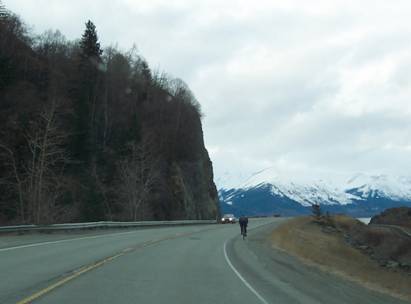
Bicycling alongside rumble strips
on the Seward Hwy
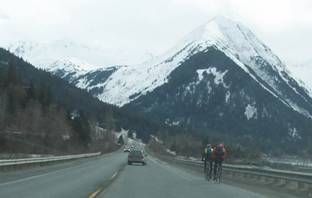
Motorist passing cyclists on the shoulder,
Seward Hwy
Why use centerline rumble strips in passing zones?
- Nearly half of all fatal and major injury head-on collisions occur within passing zones on the primary highways.
- More than half of fatal and major injury head-on collisions occur within passing zones within designated Traffic Safety Corridors in Alaska.
- Over 91 percent of the head-on crashes involved vehicles who drifted across the centerline for reasons other than passing.(Excluding snow and ice conditions.)
1. Severe crashes significant in passing zones.
Southcentral Alaska crash experience demonstrates nearly half of all fatal head-on crashes occur within passing zones on the primary highways. In designated Traffic Safety Corridors, fatal head-on crashes exceed 62 percent in passing zones. For head-on major injury crashes, passing zone crashes are 40 percent and 56 percent, respectively for primary highways and Traffic Safety Corridors.
2. Road segments in southcentral Alaska with head-on collision concentrations.
Head-on non-passing related crashes on dry or wet pavement (no snow or ice related head-on crashes) are highest within the proposed centerline rumble strip highway segments on the Glenn, Parks, Seward and Sterling Highways and a portion of Knik/Goose Bay Road. These segments represent locations with the highest incidences of head-on crashes on the major rural highways in the Central Region and Alaska as a whole. Portions of these routes where centerline rumble strips are proposed are as follows:
- Glenn Highway: Parks Highway Junction to Palmer Fairgrounds (5.25 Miles)
- Knik/Goose Bay Road: Palmer/Wasilla Highway Extension to Settlers bay (8.02 miles)
- Parks Highway:
- Church Road (Wasilla) to Houston (12.622 Miles)
- Houston to Milepost 69 (Willow) (10.382 Miles)
- Milepost 104 (Susitna River) to Milepost 114 (Trapper Creek) (9.848 Miles)
- Seward Highway:
- Milepost 8 (Grouse Creek)to Milepost 18 (Snow River Bridge) (9.593 Miles)
- Milepost 46 (near Summit lake) to Milepost 64 (Johnson Lake) (18.69 Miles)
- Milepost 87 (3 miles south of Girdwood) to Milepost 117 (Potter) (24.456 Miles)
- Sterling Highway: Milepost 83 (Moose River) to Milepost 93 (1/2 mile E of Soldotna) (9.435 Miles)
The approximate TOTAL Miles of planned centerline rumble strips along these corridors is 108 Miles. Centerline rumble strips have existed for nine years along horizontal curves along Turnagain Arm and Turnagain Hill on the Seward Highway.
3. Severe crashes are not primarily due to passing.
A total of 136 head-on crashes occurred between 1997 and 2006 on dry or wet pavements (no snow or ice) on the highway segments listed above for which centerline rumble strips will be installed in 2009 and 2010. Over 91 percent of these crashes involved vehicles that drifted across the centerline for reasons other than passing. Only 9 percent of these crashes are noted as a vehicle making an intentional passing maneuver at the time of the crash.
Four human contributing factors (driver inattention, fell asleep, improper lane use/changenot related to passing, unsafe speed) account for over half of the target head-on crashes. These roads are candidates for crash mitigation using centerline rumble strips.
Are rumble strips safe for motorcyclists?
In a recent Minnesota study, crash data for 9,845 motorcycle crashes from 1999 to 2006 were evaluated. Rural rumble strips were present in 29 of these crashes. One crash was fatal. Rumble strips were not reported as a factor in any of the crashes. All but two crashes had clear causes unrelated to rumble strips. Road surface was a potential factor in only three crashes. Roadside observations for many hours yielded a small number of rumble strip crossings, and no instances of directional changes or unusual riding behavior during crossing. Rumble strips were not considered to inhibit any passing opportunities.
Investigators concluded there was no indication centerline rumble strips pose a hazard to motorcyclists. Warning signs were considered unnecessary. New riders, however, were thought to possibly react negatively to rumble strips. Including rumble strips in motorcycle safety courses and driving examinations was recommended to address this concern.
Source: Effects of Center-Line Rumble Strips on Non-Conventional Vehicles, MNDOT Research RPT 2008-7
In Alaska, centerline rumble strips are reduced in depth to 3/8” in order to reduce the impact to motorcyclists and other users, while still providing warning to drivers. This slight change in depth is consistent with the common approach used in many other states.
Do rumble strips cause noise problems for nearby residents?
Tests have been performed in other states to measure the noise at the roadside when a passenger car drives on milled-in rumble strips. Passenger car noise levels at the roadside were 70 decibels, only 1 decibel higher than that measured for a vehicle driving on a regular road surface. The sound of 70 decibels is comparable to that of an electric sewing machine or mixer. In Alaska, many common machines generate noise this loud or louder, depending on proximity, including airplanes, motorcycles, trains, jets, ATV’s, and snowmachines.
A noise study conducted by the Texas Transportation Institute concluded the overall exterior noise was increased by road vehicles driving over rumble strips, but that the increase in noise was not significant. The noise of a road vehicle traveling at 55 miles per hour while driving over rumble strips was measured to be less than the noise of a commercial vehicle traveling on the same road without driving over the rumble strips.
Source: “Exterior Noise Created by Vehicles Traveling Over Rumble Strips”, Texas Transportation Institute, Nov 9, 2006 by M. Finley, P.E. and J. Miles, E.I.T. (presented at the Transportation Research Board annual meeting in 2007).
Do rumble strips damage the pavement?
Research has shown that rumble strips cause no noticeable degradation of new pavement. They also require little or no maintenance. In Alaska, rumble strips are not installed on pavement in poor condition.
In a Kentucky study, pavement deterioration and the accumulation of snow and ice in the rumble strip depression were evaluated. Pavement deterioration along the centerline joint was noted on the Mountain Parkway and Daniel Boone Parkway. However, it was noted this was a retrofit application and pavement performance was poor before the rumble strip placement. Other rumble strip installations did not result in any significant pavement deterioration when placed on new pavement. Water and ice accumulation in the centerline rumble strip was determined not to be an issue.
The Federal Highway Administration, Office of Safety, understood maintenance crews were initially concerned that heavy traffic would cause shoulder pavements with rumble strips to crumble faster, or that the freeze-thaw cycle of water collecting in the grooves would crack the pavement. They have determined these concerns to be unfounded.
Per FHWA’s summary, there appears to be little early deterioration of milled shoulder rumble strips on either cement concrete or asphalt pavements due to grooving or water. Rumble strips have little effect on the rate of deterioration of new pavements. Older pavement shoulders tend to degrade more quickly, but tests in several States show that these rumble strips continue to perform their original function—making noise and creating vehicle vibration. There are also no apparent problems with installation or faster deterioration of rumble strips on open-graded pavements. Road agencies do advise against installing rumble strips on pavements that are rated as deformed or that show high degrees of deformation and/or cracking distress.
Source: Rumble Strips: A Sound Investment. FHWA-SA-07-024.
How do drivers react in locations where centerline rumble strips are used in passing zones?
In a recent Texas Transportation Institute study, passing operations before and after the installation of CRSs was studied along a 15-mile stretch of two-lane rural highway. The researchers demonstrated that there were no erratic maneuvers before or after the centerline rumble strips were installed. Erratic maneuvers were defined as rapid alignment changes, overcorrection, or wrong corrective actions in a trajectory. An example of a wrong corrective action would be a driver initially moving farther to the left rather than to the right when the driver inadvertently contacted the centerline rumble strips.
The study concluded that “Neither erratic nor avoiding maneuvers were observed at the centerline rumble strip installation site. Drivers continued to exhibit normal behavior during passing movements, and no wrong trajectory corrections were observed.”
Source: Operational Effects of Shoulder and Centerline Rumble Strips on Two-Lane Undivided Highways, Texas Transportation Institute, Project 0-5577
How many states use centerline rumble strips and what is their combined experience?
States and Canadian provinces were surveyed in 2005 on their use of centerline rumble strips. Results of this survey are as follows:
Extent of Use
- In 2005, Twenty-two states and 2 Canadian provinces used centerline rumble strips.
- The number of miles of centerline rumble strips reported in a 2003 survey had greatly increased since a 2000 survey. Additional states have begun using centerline rumble strips since the 2005 survey.
- Fourteen of 24 responding agencies reporting the use of centerline rumble strips used continuous centerline rumble strips; that is, in both passing and no-passing zones.
Safety Issues
- Retroreflectivity of centerline striping: Most responding agencies (14 of 24) did not have any problem with reduced nighttime retroreflectivity.
- Anecdotal evidence suggests that centerline rumble strips increase nighttime visibility in wet conditions.
Vehicle operation
- Seventeen of the 24 responding agencies reported that there was no evidence of centerline rumble strips causing vehicles to jerk to the left.
- Passing: Most responding agencies (19 of 24) reported that placing centerline rumble strips in passing zones does not create any passing problems.
- Motorcycles: Twenty-two of the responding agencies reported that they had not received any response from the motorcycle community.
- Bicycles: Twenty-one of the 24 responding agencies reported that they did not get any response from the bicycle community.
Maintenance Issues/Concerns
- Pavement deterioration: Most responding agencies (15 of 24) reported that there was not any effect of pavement deterioration because of water accumulation.
- Noise: Fifteen responding agencies (15 of 24) did not have any noise complaints from residents.
- Snow plowing: Operators of snow-plowing equipment in one state expressed concerns about increased wear on their equipment.
Are rumble strips still effective in the winter?
Engineering Research Institute for Cold Region-Japan
On snow that has not been compacted, the noise and vibration still can be noticed even if the rumble strips are covered by snow. The noise and vibration occur even on snowy roads where the road markings are not visible. This is a great advantage in warning errant drivers even when road markings are covered by snow in winter. The snow removal and anti-freezing agents remove snow caught in grooves.
What design criteria are Alaska DOT/PF using for Rumble Strip installation?
Rumble Strip Policy
Rumble Strip Standard Drawings: Pending
